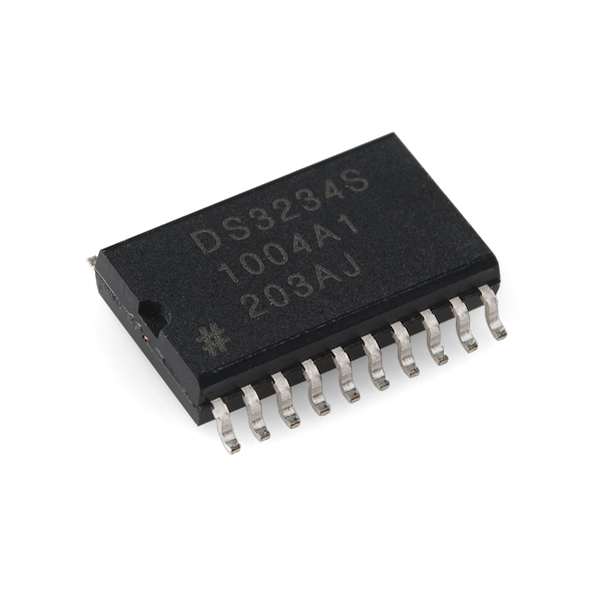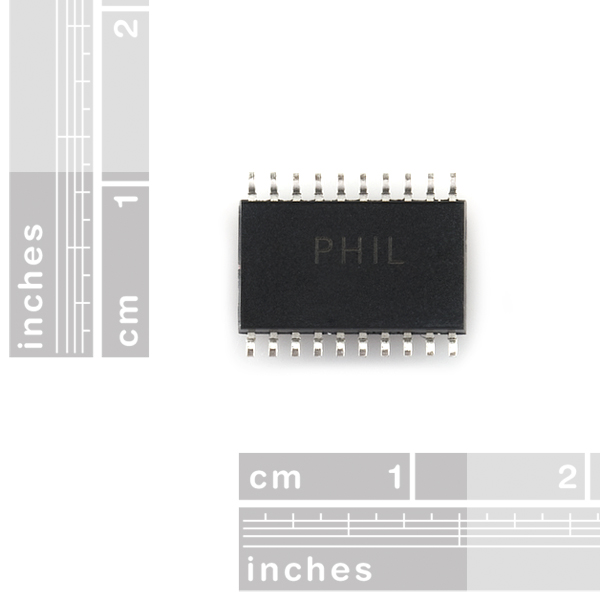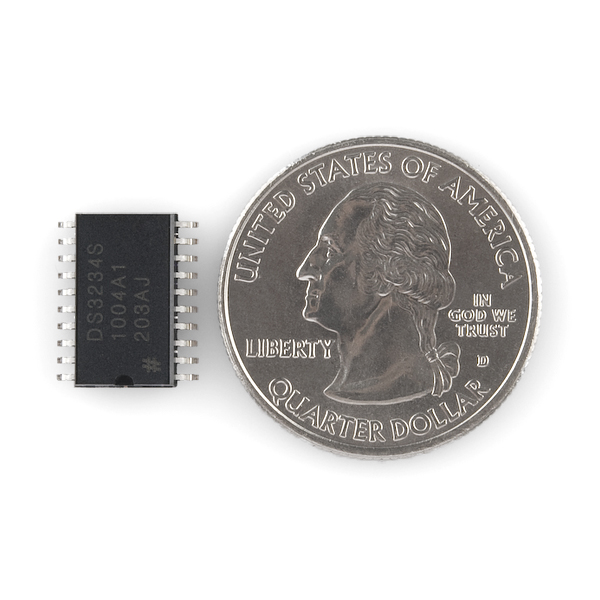RTC stands for real time clock folks. The DS3234 is a low-cost, extremely accurate SPI bus RTC with an integrated temperature compensated crystal oscillator (TCXO) and crystal.
If you aren't looking to design your own breakout board, never fear, we have you covered with the DeadOn RTC Breakout!
- Battery Backup Input for Continuous Timekeeping
- High-precision (±2ppm)
- Operating Temperature Range 0°C to +70°C
- Low-Power Consumption
- Real-Time Clock Counts Seconds, Minutes, Hours, Day, Date, Month, and Year with Leap Year Compensation Valid Up to 2099
- Two Time-of-Day Alarms
- Programmable Square-Wave Output
- 4MHz SPI Bus Supports Modes 1 and 3
- Digital Temp Sensor Output: ±3°C Accuracy
- Register for Aging Trim
- Active-Low RST Input/Output
- 300-Mil, 20-Pin SO Package
Real Time Clock - DS3234 Product Help and Resources
Core Skill: Soldering
This skill defines how difficult the soldering is on a particular product. It might be a couple simple solder joints, or require special reflow tools.
Skill Level: Competent - You will encounter surface mount components and basic SMD soldering techniques are required.
See all skill levels
Core Skill: Programming
If a board needs code or communicates somehow, you're going to need to know how to program or interface with it. The programming skill is all about communication and code.
Skill Level: Competent - The toolchain for programming is a bit more complex and will examples may not be explicitly provided for you. You will be required to have a fundamental knowledge of programming and be required to provide your own code. You may need to modify existing libraries or code to work with your specific hardware. Sensor and hardware interfaces will be SPI or I2C.
See all skill levels
Core Skill: Electrical Prototyping
If it requires power, you need to know how much, what all the pins do, and how to hook it up. You may need to reference datasheets, schematics, and know the ins and outs of electronics.
Skill Level: Competent - You will be required to reference a datasheet or schematic to know how to use a component. Your knowledge of a datasheet will only require basic features like power requirements, pinouts, or communications type. Also, you may need a power supply that?s greater than 12V or more than 1A worth of current.
See all skill levels
Comments
Looking for answers to technical questions?
We welcome your comments and suggestions below. However, if you are looking for solutions to technical questions please see our Technical Assistance page.
Customer Reviews
No reviews yet.





Vaild up to 2099? Is this the beginning of a Y2.1K bug?
It's a physical design limitation, And it is valid until 2199, not 2099. Smart software could compensate by maintaining it's own century counter in the RTC's SRAM. However i doubt this device could last more than 200 years in the field. Wikipedia has a nice article on semiconductor failure modes if your interested.
No, it's 2099, and it's nothing to do physical, it's a calendar thing. The device adds a leap day on multiples of 4 years, but 2100 is not a leap year.
no, its just the time until the plutonium 239 inside the chip reaches it's half-life
What are the dimensions of this part? I could not find them in the datasheet.
The datasheet doesn't include the actual dimension data, but rather includes a link to another document that does have it.
Hello, I've two DS3234 connected to two different Arduinos, I followed this tutorial http://www.l8ter.com/?p=375 one of them works perfectly but the other show me the following in Serial monitor:
10/10/10 10:10:0 11/11/11 11:11:11 12/12/12 12:12:12 13/13/13 13:13:13 14/14/14 14:14:14 15/15/15 15:15:15 16/16/16 16:16:16 17/17/17 17:17:17 18/18/18 18:18:18 19/19/19 19:19:19 20/0/20 20:20:20 21/1/21 21:21:21 22/2/22 22:22:22 23/3/23 23:23:23 24/4/24 24:24:24 25/5/25 25:25:25 26/6/26 26:26:26 27/7/27 27:27:27 28/8/28 28:28:28 29/9/29 29:29:29 30/10/30 3:30:30 31/11/31 4:31:31 32/12/32 5:32:32 33/13/33 6:33:33 34/14/34 7:34:34 35/15/35 8:35:35 36/16/36 9:36:36 37/17/37 10:37:37 38/18/38 11:38:38 39/19/39 12:39:39 0/0/40 0:40:40 1/1/41 1:41:41 2/2/42 2:42:42 3/3/43 3:43:43 4/4/44 4:44:44 5/5/45 5:45:45 6/6/46 6:46:46
It seems that every second increase all records in one unit, if I only read every 5 seconds they increased 5 units. Could it be a wiring or soldering problem or is the DS3234 damaged?
Best regards.
I wish I could find an inexpensive WWVB receiver circuit to go along with this to set the time automatically (radio conditions permitting, of course). Sparkfun no longer offers their WRL-10060 RoH kit and the closest thing I found was from Galleon, which sells a receiver circuit (EM2s) @ $40 and an antenna $27 plus $20 s/h.
It's cheaper to cannibalize an "atomic" clock.
is there an eagle library for this part?
It should be in the SFE library. We make a breakout for it, see below.
Wow. We've been waiting a LONG time for a board for this chip. It looks like such a great set of features for a good price. I wonder why it seems to have been orphaned by SparkFun?
While I wait for SF, it looks like I can get a 20 Pin SOIC adapter for 70 cents from Futurlec. I'll have to kludge the battery, etc. but really need to get on with the project.
Ask and you shall recieve!
any due date on the board?
Anxiously awaiting the breakout board!
Really looking for the breakout board on this one, but if it isn't forthcoming soon, I'll have to go with the chronodot from adafruit instead. Hope it's on the way...
fluidic:
Two wires less? Compatibility with existing I2C chips and peripherals?
Also, do you really need duplex comms on a clock?
Shouldn't this be under SMD ICs not General ICs?
I think i ordered an I2C version from Maxim a while back.
It was a DS32B35-33#, It even had the same package.
Eagerly awaiting the breakout board. I was looking at this chip just a couple of days before you announced you were carrying it.
This would be a good match for your PRT-09216 3.3v step-up board.
A nice addition. But could we get the DS3231 for I2C? And possibly update the DS1307 to DS1337?
2100 if I remember right is NOT a leap year, so it probably does a mod4 test.
Now if only sparkfun would do I2C. A current mirror "breakout" would solve many bus problems.